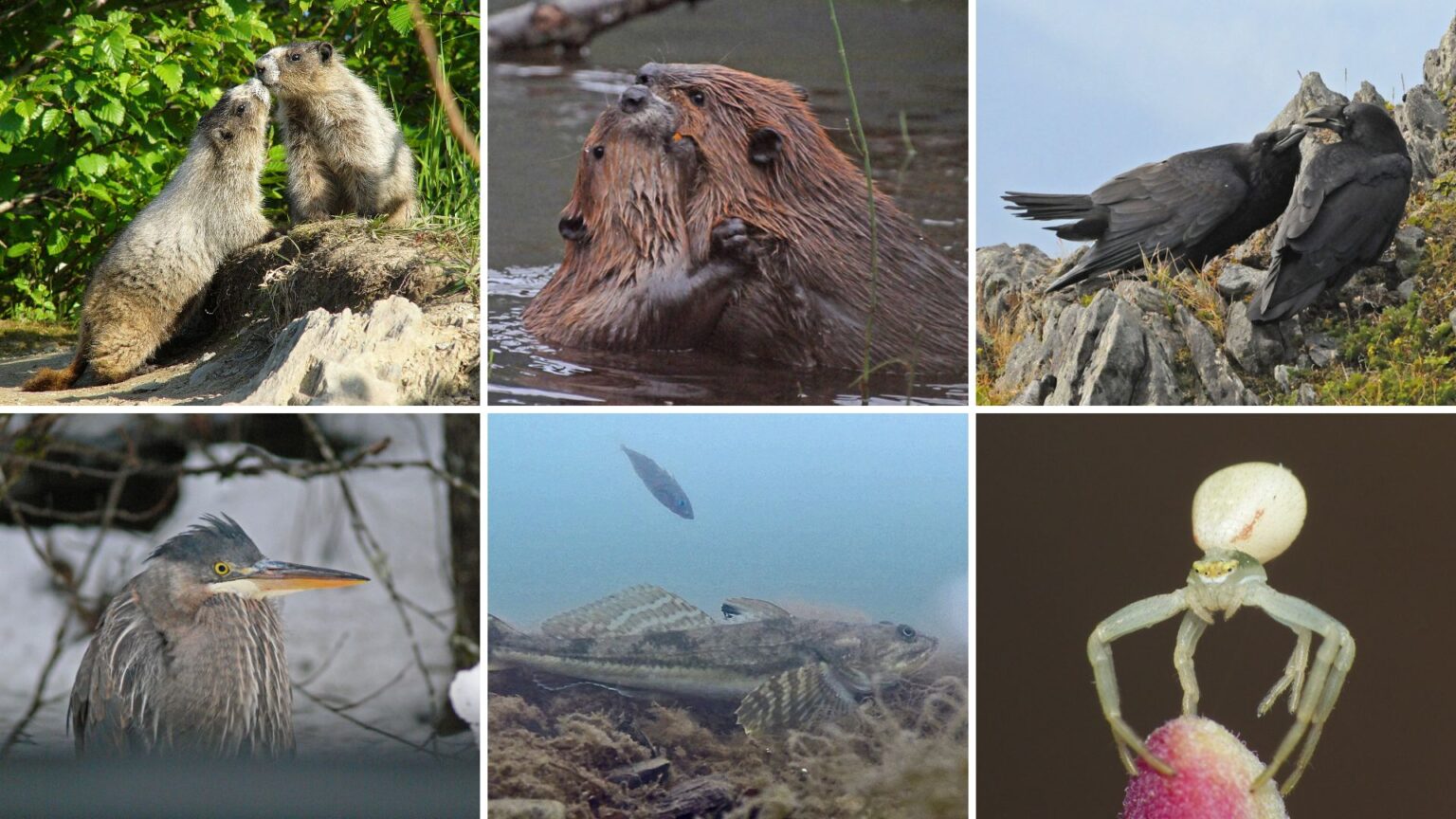I have been pleased by all the information that is available now on the emotional lives of mammals, birds, fish and insects. Of special interest are the books that discuss what is known about the subject. The authors not only cover the research they have done but they do a good job of reviewing the literature that has been published about the behavior and emotions of various creatures.
The books that I recommend are for mammals (The Emotional Lives of Animals by Marc Bekoff); for birds (Mind of the Raven by Bernd Heinrich); for fish (What a Fish Knows by Jonathon Balcombe); for insects (Super Fly by Jonathan Balcombe) and (The Mind of a Bee by Lars Chittka).
I often spend months and sometimes years trying to understand the behavior of certain creatures in the wild. And eventually write a book about what I have observed. Here are a few images and short stories that have impressed me the most.
Mammals
Hoary marmots that live along our beaches and in the alpine often play with each other. When they get separated and return they often “touch noses” which sometimes appears that they are kissing each other (Figure 1). When I watch and film beavers I often see a probable parent interacting and sometimes “cuddling” one of its kids (Figure 2).
Birds
In the Juneau alpine I watched ravens passing rocks to one another. If the raven receiving the rock did not “like” the rock it would attack the other raven. Weird behavior! (Figure 3). One day I drove out to the Mendenhall Glacier area and saw some eagles feeding on a salmon carcass. I stopped the car to watch them and they flew away. Then this Great Blue Heron came out of the brush and ate the carcass. Afterwards it walked up to my car and stared at me from about two feet away at the open window area. What was it thinking? (Figure 4).
Fish
I have done quite a bit of filming the underwater behavior of Three-spine Sticklebacks in Juneau. The amount of effort that the males do to protect their nests, eggs, and young is very interesting. This photo shows a stickleback about to attack a Staghorn Sculpin that settled near the sticklebacks nest (Figure 5). It did this several times and the sculpin would attempt to eat the stickleback, which would successfully dart out of the sculpin’s mouth. Eventually it was successful in driving the sculpin away. Also, there is scientific report that documents the ability of sticklebacks to recognize the faces of the numerous other ones in their colony. I would lower a mirror underwater with a gopro camera attached. Every stickleback that approached the mirror would attack its image. Since they cannot recognize their own face they obviously thought it was one outside of their colony.
Insects
I watched and filmed crab spiders in the Juneau area for three summers. These spiders do not build webs. To catch prey they hunt on the flowers that insects visit (Figure 6). The most exciting event was filming the mating behavior of the males. The females typically will grab and eat a male that approaches her. So the males have to be extremely careful and use special techniques to mate successfully. What I filmed was a female eating one male and another came and mated with her while she was busy eating.
I think the most interesting book that I have helped write is one that Mary Willson and I wrote on the Natural Connections in Alaska. To see a pdf of this book look here.
To see a more detailed version of this article look here.
Bob Armstrong’s books include Guide to the Birds of Alaska; Alaska’s Birds; Alaska’s Fish and Photographing Nature in Alaska. In addition he has coauthored Aquatic Insects in Alaska; The Nature of Southeast Alaska; Alaska’s Natural Wonders; Southeast Alaska’s Natural World; Whistlers on the Mountains; Along the Mt. Roberts Trail in Juneau, Alaska; Dragonflies of Alaska; Dragons in the Ponds and Life around Mendenhall Glacier in Juneau Alaska. He has also authored and coauthored numerous scientific and popular articles on fish, birds, mammals, plants, and insects in Alaska. Many of these books and articles are now available for free as a PDF on his website under links and resources. Also all of the books he has self-published have links to PDF’s of them under the category BOOKS and are available for downloading for free. He has worked as a fishery biologist and research supervisor for the Alaska Department of Fish and Game and as an Associate Professor for the University of Alaska where he taught courses in fisheries and ornithology. He currently lives in Juneau and continues to photograph and write about the Natural History of Alaska.


Fascinating! Thanks for sharing, Bob.